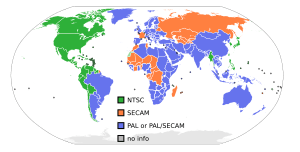PAL facts for kids
PAL (short for Phase Alternating Line) is a way to add color to old-style analogue television broadcasts. It is one of the main TV standards still used today. The other two are SECAM and NTSC.
Contents
Why Europe Needed PAL
In the 1950s, European countries wanted to start broadcasting color television. However, they had a few problems. The NTSC standard, used in America, works with a 60 Hz AC electricity supply. But in Europe, the electricity supply uses 50 Hz.
TV studios' lightbulbs change their brightness at twice the electricity supply frequency. If the TV picture rate doesn't match the power grid frequency, a dark bar can appear on the TV screen. This bar would move up or down the screen. This happens because of something called the stroboscope effect. It's the same effect that makes car wheels look like they're spinning backward on TV.
The NTSC system also had a weakness: its color could change if the TV signal wasn't very strong or clear. Because of these issues, experts started to develop new color TV standards like SECAM and PAL. Their goal was to create a color TV standard that worked well with 50 fields per second (50 hertz) and offered better color than NTSC.
Who Developed PAL?
The PAL system was created by Walter Bruch at a company called Telefunken in Germany. It was first shown to the public in 1963. The first TV shows using PAL began broadcasting in the United Kingdom and Germany in 1967.
Later, the French electronics company Thomson bought Telefunken. Thomson also bought another company, Compagnie Générale de Télévision, where Henri de France had developed SECAM. SECAM was the first European color television standard. Today, Thomson also partly owns the RCA brand, which was involved in creating the NTSC color TV standard.
PAL: More Than Just Color
The word PAL is often used in a general way to describe a TV system with 625 lines and 50 Hz. This is common in Europe. People use it to tell it apart from the NTSC system, which has 525 lines and 60 Hz, mainly used in North America and Japan.
For example, when you see DVDs labeled as either PAL or NTSC, this usually refers to the number of lines and the frame rate. It doesn't technically mean the European discs use the PAL color system. This can sometimes make people think that PAL decides the picture's resolution, but it doesn't. The PAL color system can actually be used with different resolutions and frame rates. NTSC, however, does define the video line and frame format.
Related pages
Images for kids
See also
 In Spanish: PAL para niños
In Spanish: PAL para niños










